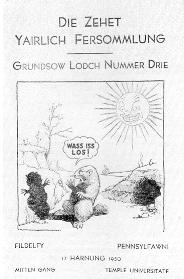From Trommler and McVeigh (eds.), America and the Germans, Vol. I, Philadelphia: University of Pennsylvania Press, 1985, p. 56

In the U.S. it is known as Groundhog Day. In Catholic tradition February 2 is Candlemas Day (Maria Lichtmess), the feast day commemorating the purification of the Virgin Mary and the presentation of Jesus in the Temple at Jerusalem. It is named after the candle light procession which precedes the mass. Candles are also blessed on this day.
Since the celebration of the winter solstice, by Candlemas, the sun has gained one whole hour. In the Black Forest the spinning wheel would now be put aside:
"Lichtmess, Spinnen vergess, by Tag zu Nacht ess"
Candlemas, forget spinning, eat supper by daylight.
Sunny weather in early February is a bad omen for the arrival of Spring and German sayings abound:
| Wenn's an Lichtmess stürmt und
schneit, ist der Frühling nicht mehr weit; ist es aber klar und hell, kommt der Lenz noch nicht so schnell | When it storms and snows on
Candlemas Day, Spring is not far away; if it's bright and clear, Spring is not yet near). |
The groundhog forecast is based on a German tradition brought to Pennsylvania in 1887.
"Wenn der Bäzu Lichtmess seinen Schatten sieht,The bear has been replaced by the badger (Dachs) or hedgehog (Igel) and in the U.S. by the groundhog (woodchuck, a species of marmot).
so kriecht er wieder auf sechs Wochen ins Loch"(When the bear sees his shadow at Candlemas,
he will crawl back into his hole for another six weeks.)
The official forecast for the arrival of Spring is given by Punxsutawney Phil from his heated burrow (lodge) at Punxsutawney, Pennsylvania. In 1993, after a nose-to-nose chat with the president of his Inner Circle, the town group that actually determines the prediction, days before the big event, "Phil" declared: "six more weeks of winter there'll be;" he had seen his shadow.
Indianapolis' groundhog Henrietta's place--she died a few years earlier--was taken in 1993 by a hedgehog named Hilary.
Ruth Reichmann
Max Kade German-American Center
I came across some interesting info re: the PA German Grundsau lodge tradition and its links to PA German cultural identity. These lodges were founded in the post WWI period to aid in the continuation of PA German dialect. They are named after the dialect word for the woodchuck...a direct translation of the English pioneer term...ground hog... into PA German dialect since the animal is not really found in Europe where instead the European marmot takes its eco-niche.
As has been discussed, the Groundhog Day tradition is related to the ancient German belief re: Lichtmesse and the badger re: seasons etc. Thus the idea is a spin off from the original German and represents a cultural continuity of sorts. Now for the interesting info.
The modern Grundsau Lodges feature dinners held on Feb 2...Lichtmess...aka Groundhog Day to most Americans...where dialect only is spoken and menfolk (now including women as well) dine on PA German foods and swap tales, put on skits etc. Lodges of course are a fixture of much of traditional American social life...especially during the Depression era, when this movement got started...thus it appears on the surface to be a harmless form of regional Americana with some German "overtones".
What I found out., although I have sensed it and suspected it from chronology and American history, is that the cloaking of German dialect preservation in a fraternal sort of environment was actually in response to the anti-German feelings in America during the first half of this century.
The Grundsau tradition is essentially an attempt to get PA Germans to keep the dialect and traditions in mind in the face of anti-German feelings in American society. This was the intention of the founders of the lodge system.
While I had known of the Grundsau tradition for decades, I have never seen it discussed in light of a conscious reaction to anti-German elements in American society, but it fits very nicely chronologically with American history. I am attempting to find out more and get some documentation on this, since for me it fills in a few gaps that I have always sensed about PA German identity and broader elements of Germans in America.
D. Croll
| Program of the 10th annual meeting of Groundhog-Lodge No. 3,
Temple University, Philadelphia, February 17, 1950. Since the
1930s such evenings conducted in dialect, primarily around the
time of Candlemas (February 2), have contributed to renewal of
group identity among Pennsylvania Germans. (Roughwood Collection) From Trommler and McVeigh (eds.), America and the Germans, Vol. I, Philadelphia: University of Pennsylvania Press, 1985, p. 56 |
 |
From
http://waldorf-net.de/darmstadt/kig-haup.htm#Unser Kindergarten
Wenn die Kinder nach Weihnachten wieder in den Kindergarten kommen, leben noch
in den Herzen die Krippenspiele der Adventszeit, leben auf im Freispiel, aber auf dem
Jahreszeitentisch ist jetzt die Krippe mit der Anbetung der Könige. Während diese
heimwärts ziehen und Maria und Josef mit dem Kinde auf der Flucht nach Ägypten
sind, klingt die Weihnachtszeit im Kindergarten ab. Auf Mariä Lichtmeß zu, wenn
draußen die Qualität des Lichtes auf einmal ganz anders wird, ist eines Morgens die
Königskrippe auch verschwunden.
From http://www.geocities.com/Eureka/7933/kirchen.html
Während der Weihnachtszeit, (sie
umfaßt die Zeit vom Advent bis Maria Lichtmess), nimmt die Krippe mit wechselnder
Zusammenstellung der Figuren ihren Platz links des Altars ein.
Candlemas and Karneval
Vorfasnetszeit: Fasnetbrauch in Endingen
In der Vorfasnetszeit warten die Kinder in der Stadt sehnsüchtig auf das Fest Maria Lichtmeß, denn
ab diesem Tag dürfen sie, als Hexen verkleidet, ihren Schabernack im Städtchen treiben.
Lichtmeß hell und rein, wird ein langer Winter sein
Lichtmeß trüb, ist dem Bauern lieb
der Lichtmeß-Sonnenschein, bringt großen Schnee herein
ist´s Lichtmeß licht, geht der Winter nicht
Lichtmeß im Klee, Palmsonntag im Schnee
weiße Lichtmeß - grüne Ostern
wenn´s an Lichtmeß stürmt und schneit, ist der Frühling nicht weit
Lichtmess im Klee, Ostern im Schnee.
OTHER RESOURCES: